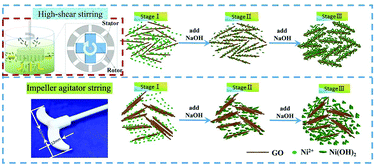Effects of high-shear mixing and the graphene oxide weight fraction on the electrochemical properties of the GO/Ni(OH)2 electrode†
Abstract
A high-shear mixer was used in the process of chemical precipitation to prepare graphene oxide (GO) and Ni(OH)2 composites with different weight fractions of GO from 0 wt% to 2.6 wt%. The GO/Ni(OH)2 composite with 1.5 wt% GO prepared by high-shear mixing (1.5GO/Ni(OH)2–H) displayed a high specific capacitance (1836 F g−1 at 2 mV s−1), which was beyond that (1581 F g−1 at 2 mV s−1) of GO/Ni(OH)2 obtained by impeller agitator stirring (1.5GO/Ni(OH)2–M). 1.5GO/Ni(OH)2–H also showed excellent cycling stability, retaining 91.7% of its initial specific capacitance after 2000 cycles. Furthermore, the asymmetric device (the 1.5GO/Ni(OH)2–H as the positive electrode and active carbon as the negative electrode) exhibited a high energy density of 41.2 W h kg−1 at a power density of 1500 W kg−1 with a voltage of 1.5 V. In addition, the effects of high-shear mixing and impeller agitator stirring on the microstructures and electrochemical properties of the composites were discussed, which indicated that high-shear mixing could exfoliate graphene oxide and restrain the grain growth of Ni(OH)2, thus leading to excellent electrochemical performance.



 Please wait while we load your content...
Please wait while we load your content...